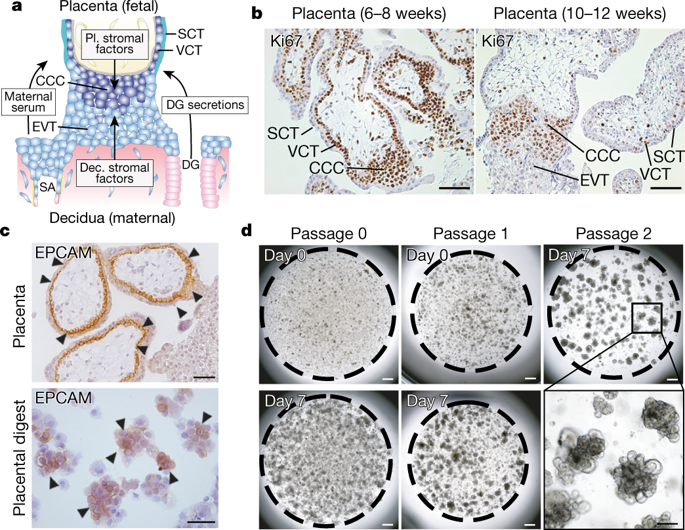Our official English website, www.x-mol.net, welcomes your feedback! (Note: you will need to create a separate account there.)
Trophoblast organoids as a model for maternal–fetal interactions during human placentation
Nature ( IF 64.8 ) Pub Date : 2018-11-28 , DOI: 10.1038/s41586-018-0753-3 Margherita Y Turco 1, 2, 3 , Lucy Gardner 1, 3 , Richard G Kay 4 , Russell S Hamilton 2, 3 , Malwina Prater 2, 3 , Michael S Hollinshead 1 , Alasdair McWhinnie 5 , Laura Esposito 1 , Ridma Fernando 2, 3 , Helen Skelton 1 , Frank Reimann 4 , Fiona M Gribble 4 , Andrew Sharkey 1, 3 , Steven G E Marsh 5, 6 , Stephen O'Rahilly 4 , Myriam Hemberger 3, 7 , Graham J Burton 2, 3 , Ashley Moffett 1, 3
Nature ( IF 64.8 ) Pub Date : 2018-11-28 , DOI: 10.1038/s41586-018-0753-3 Margherita Y Turco 1, 2, 3 , Lucy Gardner 1, 3 , Richard G Kay 4 , Russell S Hamilton 2, 3 , Malwina Prater 2, 3 , Michael S Hollinshead 1 , Alasdair McWhinnie 5 , Laura Esposito 1 , Ridma Fernando 2, 3 , Helen Skelton 1 , Frank Reimann 4 , Fiona M Gribble 4 , Andrew Sharkey 1, 3 , Steven G E Marsh 5, 6 , Stephen O'Rahilly 4 , Myriam Hemberger 3, 7 , Graham J Burton 2, 3 , Ashley Moffett 1, 3
Affiliation

|
The placenta is the extraembryonic organ that supports the fetus during intrauterine life. Although placental dysfunction results in major disorders of pregnancy with immediate and lifelong consequences for the mother and child, our knowledge of the human placenta is limited owing to a lack of functional experimental models1. After implantation, the trophectoderm of the blastocyst rapidly proliferates and generates the trophoblast, the unique cell type of the placenta. In vivo, proliferative villous cytotrophoblast cells differentiate into two main sub-populations: syncytiotrophoblast, the multinucleated epithelium of the villi responsible for nutrient exchange and hormone production, and extravillous trophoblast cells, which anchor the placenta to the maternal decidua and transform the maternal spiral arteries2. Here we describe the generation of long-term, genetically stable organoid cultures of trophoblast that can differentiate into both syncytiotrophoblast and extravillous trophoblast. We used human leukocyte antigen (HLA) typing to confirm that the organoids were derived from the fetus, and verified their identities against four trophoblast-specific criteria3. The cultures organize into villous-like structures, and we detected the secretion of placental-specific peptides and hormones, including human chorionic gonadotropin (hCG), growth differentiation factor 15 (GDF15) and pregnancy-specific glycoprotein (PSG) by mass spectrometry. The organoids also differentiate into HLA-G+ extravillous trophoblast cells, which vigorously invade in three-dimensional cultures. Analysis of the methylome reveals that the organoids closely resemble normal first trimester placentas. This organoid model will be transformative for studying human placental development and for investigating trophoblast interactions with the local and systemic maternal environment.An in vitro system that generates three-dimensional cultures of extraembryonic fetal trophoblast cells that differentiate into the two main types of trophoblast can be used to study human placental development.
中文翻译:

滋养层类器官作为人类胎盘期间母胎相互作用的模型
胎盘是胚胎外器官,在宫内生活中支持胎儿。尽管胎盘功能障碍会导致严重的妊娠疾病,对母亲和孩子造成直接和终身的后果,但由于缺乏功能性实验模型,我们对人类胎盘的了解有限。植入后,胚泡的滋养外胚层迅速增殖并产生滋养层,这是胎盘的独特细胞类型。在体内,增殖的绒毛细胞滋养层细胞分化为两个主要亚群:合体滋养层,负责营养交换和激素产生的绒毛多核上皮,以及绒毛外滋养层细胞,将胎盘固定在母体蜕膜上并转化母体螺旋动脉2 . 在这里,我们描述了可分化为合胞体滋养层和绒毛外滋养层的长期、遗传稳定的类器官培养物的滋养层的产生。我们使用人类白细胞抗原 (HLA) 分型来确认类器官来自胎儿,并根据四个滋养层特异性标准验证它们的身份。培养物组织成绒毛状结构,我们通过质谱检测到胎盘特异性肽和激素的分泌,包括人绒毛膜促性腺激素 (hCG)、生长分化因子 15 (GDF15) 和妊娠特异性糖蛋白 (PSG)。这些类器官还分化成 HLA-G+ 绒毛外滋养层细胞,这些细胞在三维培养物中强烈侵入。对甲基化组的分析表明,类器官与正常的孕早期胎盘非常相似。这种类器官模型对于研究人类胎盘发育和研究滋养层与局部和全身母体环境的相互作用将具有变革性。体外系统可产生分化为两种主要类型滋养层的胚胎外胎儿滋养层细胞的三维培养物。用于研究人类胎盘发育。
更新日期:2018-11-28
中文翻译:

滋养层类器官作为人类胎盘期间母胎相互作用的模型
胎盘是胚胎外器官,在宫内生活中支持胎儿。尽管胎盘功能障碍会导致严重的妊娠疾病,对母亲和孩子造成直接和终身的后果,但由于缺乏功能性实验模型,我们对人类胎盘的了解有限。植入后,胚泡的滋养外胚层迅速增殖并产生滋养层,这是胎盘的独特细胞类型。在体内,增殖的绒毛细胞滋养层细胞分化为两个主要亚群:合体滋养层,负责营养交换和激素产生的绒毛多核上皮,以及绒毛外滋养层细胞,将胎盘固定在母体蜕膜上并转化母体螺旋动脉2 . 在这里,我们描述了可分化为合胞体滋养层和绒毛外滋养层的长期、遗传稳定的类器官培养物的滋养层的产生。我们使用人类白细胞抗原 (HLA) 分型来确认类器官来自胎儿,并根据四个滋养层特异性标准验证它们的身份。培养物组织成绒毛状结构,我们通过质谱检测到胎盘特异性肽和激素的分泌,包括人绒毛膜促性腺激素 (hCG)、生长分化因子 15 (GDF15) 和妊娠特异性糖蛋白 (PSG)。这些类器官还分化成 HLA-G+ 绒毛外滋养层细胞,这些细胞在三维培养物中强烈侵入。对甲基化组的分析表明,类器官与正常的孕早期胎盘非常相似。这种类器官模型对于研究人类胎盘发育和研究滋养层与局部和全身母体环境的相互作用将具有变革性。体外系统可产生分化为两种主要类型滋养层的胚胎外胎儿滋养层细胞的三维培养物。用于研究人类胎盘发育。


























 京公网安备 11010802027423号
京公网安备 11010802027423号